Java的23种设计模式(二) 有更新!
- 37套精品Java架构师高并发高性能高可用分布式集群电商缓存性能调优设计项目实战视教程 置顶! 有更新!
- (五)原型模式(Prototype)
- 1. 浅复制
- 2. 深复制
- 3. 实例
- (六)适配器模式(Adpter)
- 1. 类的适配器模式
- 2. 对象的适配器模式
- 3. 接口的适配器模式
- 4. 应用场景
- (七)装饰模式(Decorator)
- (八)代理模式(Proxy)
- (九)外观模式(Facade)
- (十)桥接模式(Bridge)
37套精品Java架构师高并发高性能高可用分布式集群电商缓存性能调优设计项目实战视教程 置顶! 有更新!
(五)原型模式(Prototype)
原型模式虽然是创建型的模式,但是与工程模式没有关系,从名字即可看出,该模式的思想就是将一个对象作为原型,对其进行复制、克隆,产生一个和原对象类似的新对象。本小结会通过对象的复制,进行讲解。复制分为浅复制与深复制。
1. 浅复制
将一个对象复制后,基本数据类型的变量都会重新创建,而引用类型,指向的还是原对象所指向的。clone()就是浅复制。
2. 深复制
将一个对象复制后,不论是基本数据类型还有引用类型,都是重新创建的。简单来说,就是深复制进行了完全彻底的复制,而浅复制不彻底。要实现深复制,需要采用流的形式读入当前对象的二进制输入,再写出二进制数据对应的对象。
3. 实例
在Java中,复制对象是通过clone()实现的,先创建一个原型类:
|
public class Prototype implements Cloneable, Serializable { private static final long serialVersionUID = 1L; private String string; private SerializableObject obj; /* 浅复制 */ public Object clone() throws CloneNotSupportedException { Prototype proto = (Prototype) super.clone(); return proto; } /* 深复制 */ public Object deepClone() throws IOException, ClassNotFoundException { /* 写入当前对象的二进制流 */ ByteArrayOutputStream bos = new ByteArrayOutputStream(); ObjectOutputStream oos = new ObjectOutputStream(bos); oos.writeObject(this); /* 读出二进制流产生的新对象 */ ByteArrayInputStream bis = new ByteArrayInputStream(bos.toByteArray()); ObjectInputStream ois = new ObjectInputStream(bis); return ois.readObject(); } public String getString() { return string; } public void setString(String string) { this.string = string; } public SerializableObject getObj() { return obj; } public void setObj(SerializableObject obj) { this.obj = obj; } } class SerializableObject implements Serializable { private static final long serialVersionUID = 1L; } |
|
public class Test { public static void main(String[] args) { SerializableObject pObject = new SerializableObject(); System.out.println(pObject); Prototype obj = new Prototype(); obj.setObj(pObject); try { Prototype obj2 = (Prototype) obj.clone(); System.out.println(obj2.getObj()); Prototype obj3 = (Prototype) obj.deepClone(); System.out.println(obj3.getObj()); } catch (CloneNotSupportedException e) { e.printStackTrace(); } catch (ClassNotFoundException e) { // TODO Auto-generated catch block e.printStackTrace(); } catch (IOException e) { // TODO Auto-generated catch block e.printStackTrace(); } } } |
|
com.bomo.designpattern.prototype.SerializableObject@7700b3c2 com.bomo.designpattern.prototype.SerializableObject@7700b3c2 com.bomo.designpattern.prototype.SerializableObject@6909037d |
(六)适配器模式(Adpter)
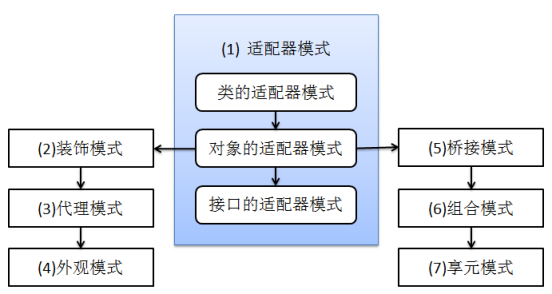
适配器模式将某个类的接口转换成客户端期望的另一个接口表示,目的是消除由于接口不匹配所造成的类的兼容性问题。主要分为三类:类的适配器模式、对象的适配器模式、接口的适配器模式。
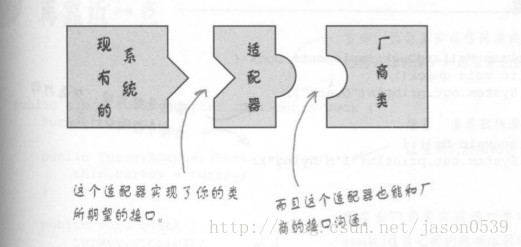
1. 类的适配器模式
首先,我们来看看类的适配器模式,先看类图:
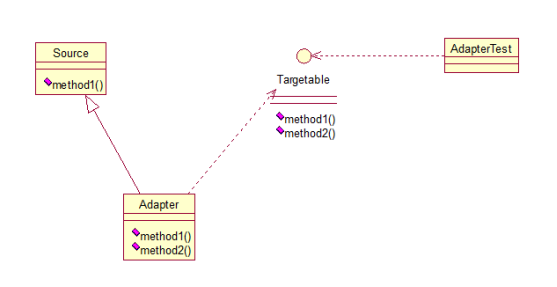
核心思想就是:有一个Source类,拥有一个方法,待适配,目标接口是Targetable,通过Adapter类,将Source的功能扩展到Targetable里,看代码:
|
public class Source { public void method1() { System.out.println("this is original method!"); } } |
|
public interface Targetable { /* 与原类中的方法相同 */ public void method1(); /* 新类的方法 */ public void method2(); } |
|
public class Adapter extends Source implements Targetable { @Override public void method2() { System.out.println("this is the targetable method!"); } } |
|
public class AdapterTest { public static void main(String[] args) { Targetable target = new Adapter(); target.method1(); target.method2(); } } |
这样Targetable接口的实现类就具有了Source类的功能。
2. 对象的适配器模式
基本思路和类的适配器模式相同,只是将Adapter类作修改,这次不继承Source类,而是持有Source类的实例,以达到解决兼容性的问题。看图:
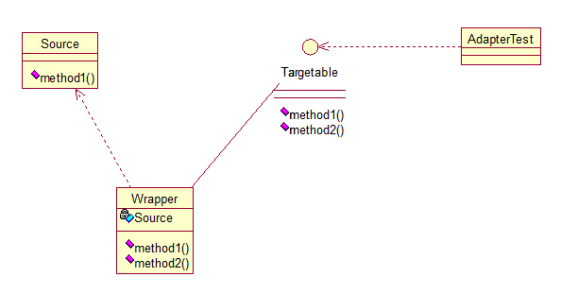
只需要修改Adapter类的源码即可:
|
public class Wrapper implements Targetable { private Source source; public Wrapper(Source source){ super(); this.source = source; } @Override public void method2() { System.out.println("this is the targetable method!"); } @Override public void method1() { source.method1(); } } |
|
public class AdapterTest { public static void main(String[] args) { Source source = new Source(); Targetable target = new Wrapper(source); target.method1(); target.method2(); } } |
输出与第一种一样,只是适配的方法不同而已。
3. 接口的适配器模式
第三种适配器模式是接口的适配器模式,接口的适配器是这样的:有时我们写的一个接口中有多个抽象方法,当我们写该接口的实现类时,必须实现该接口的所有方法,这明显有时比较浪费,因为并不是所有的方法都是我们需要的,有时只需要某一些,此处为了解决这个问题,我们引入了接口的适配器模式,借助于一个抽象类,该抽象类实现了该接口,实现了所有的方法,而我们不和原始的接口打交道,只和该抽象类取得联系,所以我们写一个类,继承该抽象类,重写我们需要的方法就行。看一下类图:
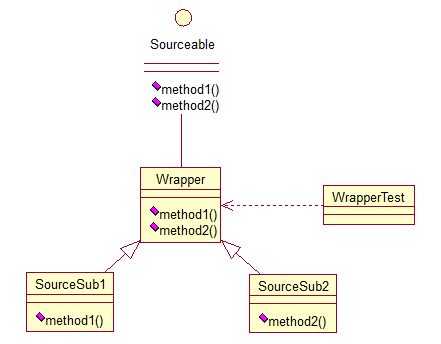
这个很好理解,在实际开发中,我们也常会遇到这种接口中定义了太多的方法,以致于有时我们在一些实现类中并不是都需要。看代码:
|
public interface Sourceable { public void method1(); public void method2(); } |
|
public abstract class Wrapper2 implements Sourceable{ public void method1(){} public void method2(){} } |
|
public class SourceSub1 extends Wrapper2 { public void method1(){ System.out.println("the sourceable interface's first Sub1!"); } } |
|
public class SourceSub2 extends Wrapper2 { public void method2(){ System.out.println("the sourceable interface's second Sub2!"); } } |
|
public class WrapperTest { public static void main(String[] args) { Sourceable source1 = new SourceSub1(); Sourceable source2 = new SourceSub2(); source1.method1(); source1.method2(); source2.method1(); source2.method2(); } } |
|
the sourceable interface's first Sub1! the sourceable interface's second Sub2! |
达到了我们的效果!
4. 应用场景
总结一下三种适配器模式的:
类的适配器模式:当希望将一个类转换成满足另一个新接口的类时,可以使用类的适配器模式,创建一个新类,继承原有的类,实现新的接口即可。
对象的适配器模式:当希望将一个对象转换成满足另一个新接口的对象时,可以创建一个Wrapper类,持有原类的一个实例,在Wrapper类的方法中,调用实例的方法就行。
接口的适配器模式:当不希望实现一个接口中所有的方法时,可以创建一个抽象类Wrapper,实现所有方法,我们写别的类的时候,继承抽象类即可。
(七)装饰模式(Decorator)
顾名思义,装饰模式就是给一个对象增加一些新的功能,而且是动态的,要求装饰对象和被装饰对象实现同一个接口,装饰对象持有被装饰对象的实例,关系图如下:
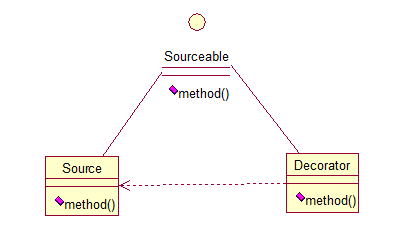
Source类是被装饰类,Decorator类是一个装饰类,可以为Source类动态的添加一些功能,代码如下:
|
public interface Sourceable { public void method(); } |
|
public class Source implements Sourceable { @Override public void method() { System.out.println("the original method!"); } } |
|
public class Decorator implements Sourceable { private Sourceable source; public Decorator(Sourceable source){ super(); this.source = source; } @Override public void method() { System.out.println("before decorator!"); source.method(); System.out.println("after decorator!"); } } |
|
public class DecoratorTest { public static void main(String[] args) { Sourceable source = new Source(); Sourceable obj = new Decorator(source); obj.method(); } } |
|
before decorator! the original method! after decorator! |
装饰器模式的应用场景:
1、需要扩展一个类的功能。
2、动态的为一个对象增加功能,而且还能动态撤销。(继承不能做到这一点,继承的功能是静态的,不能动态增删。)
缺点:产生过多相似的对象,不易排错!
(八)代理模式(Proxy)
其实每个模式名称就表明了该模式的作用,代理模式就是多一个代理类出来,替原对象进行一些操作,比如我们在租房子的时候回去找中介,为什么呢?因为你对该地区房屋的信息掌握的不够全面,希望找一个更熟悉的人去帮你做,此处的代理就是这个意思。再如我们有的时候打官司,我们需要请律师,因为律师在法律方面有专长,可以替我们进行操作,表达我们的想法。先来看看关系图:
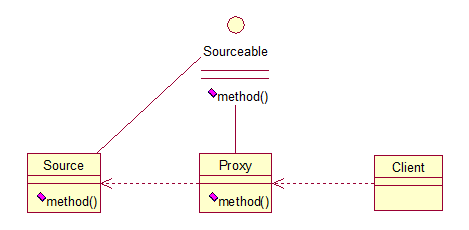
根据上文的阐述,代理模式就比较容易的理解了,我们看下代码:
|
public interface Sourceable { public void method(); } |
|
public class Source implements Sourceable { @Override public void method() { System.out.println("the original method!"); } } |
|
public class Proxy implements Sourceable { private Source source; public Proxy(){ super(); this.source = new Source(); } @Override public void method() { before(); source.method(); atfer(); } private void atfer() { System.out.println("after proxy!"); } private void before() { System.out.println("before proxy!"); } } |
|
public class ProxyTest { public static void main(String[] args) { Sourceable source = new Proxy(); source.method(); } } |
|
before proxy! the original method! after proxy! |
代理模式的应用场景:
如果已有的方法在使用的时候需要对原有的方法进行改进,此时有两种办法:
1、修改原有的方法来适应。这样违反了“对扩展开放,对修改关闭”的原则。
2、就是采用一个代理类调用原有的方法,且对产生的结果进行控制。这种方法就是代理模式。
使用代理模式,可以将功能划分的更加清晰,有助于后期维护!
(九)外观模式(Facade)
外观模式是为了解决类与类之家的依赖关系的,像spring一样,可以将类和类之间的关系配置到配置文件中,而外观模式就是将他们的关系放在一个Facade类中,降低了类类之间的耦合度,该模式中没有涉及到接口,看下类图:(我们以一个计算机的启动过程为例)
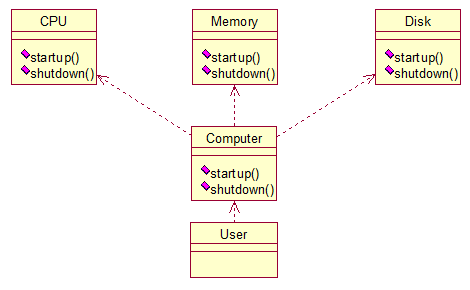
我们先看下实现类:
|
public class CPU { public void startup(){ System.out.println("cpu startup!"); } public void shutdown(){ System.out.println("cpu shutdown!"); } } |
|
public class Disk { public void startup(){ System.out.println("disk startup!"); } public void shutdown(){ System.out.println("disk shutdown!"); } } |
|
public class Memory { public void startup(){ System.out.println("memory startup!"); } public void shutdown(){ System.out.println("memory shutdown!"); } } |
|
public class Computer { private CPU cpu; private Memory memory; private Disk disk; public Computer(){ cpu = new CPU(); memory = new Memory(); disk = new Disk(); } public void startup(){ System.out.println("start the computer!"); cpu.startup(); memory.startup(); disk.startup(); System.out.println("start computer finished!"); } public void shutdown(){ System.out.println("begin to close the computer!"); cpu.shutdown(); memory.shutdown(); disk.shutdown(); System.out.println("computer closed!"); } } |
|
public class User { public static void main(String[] args) { Computer computer = new Computer(); computer.startup(); computer.shutdown(); } } |
|
start the computer! cpu startup! memory startup! disk startup! start computer finished! begin to close the computer! cpu shutdown! memory shutdown! disk shutdown! computer closed! |
如果我们没有Computer类,那么,CPU、Memory、Disk他们之间将会相互持有实例,产生关系,这样会造成严重的依赖,修改一个类,可能会带来其他类的修改,这不是我们想要看到的,有了Computer类,他们之间的关系被放在了Computer类里,这样就起到了解耦的作用,这,就是外观模式!
(十)桥接模式(Bridge)
桥接模式就是把事物和其具体实现分开,使他们可以各自独立的变化。桥接的用意是:将抽象化与实现化解耦,使得二者可以独立变化,像我们常用的JDBC桥DriverManager一样,JDBC进行连接数据库的时候,在各个数据库之间进行切换,基本不需要动太多的代码,甚至丝毫不用动,原因就是JDBC提供统一接口,每个数据库提供各自的实现,用一个叫做数据库驱动的程序来桥接就行了。我们来看看关系图:
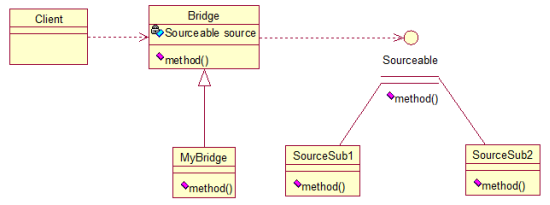
实现代码:
|
public interface Sourceable { public void method(); } |
|
public class SourceSub1 implements Sourceable { @Override public void method() { System.out.println("this is the first sub!"); } } |
|
public class SourceSub2 implements Sourceable { @Override public void method() { System.out.println("this is the second sub!"); } } |
|
public abstract class Bridge { private Sourceable source; public void method(){ source.method(); } public Sourceable getSource() { return source; } public void setSource(Sourceable source) { this.source = source; } } |
|
public class MyBridge extends Bridge { public void method(){ getSource().method(); } } |
|
public class BridgeTest { public static void main(String[] args) { Bridge bridge = new MyBridge(); Sourceable source1 = new SourceSub1(); bridge.setSource(source1); bridge.method(); Sourceable source2 = new SourceSub2(); bridge.setSource(source2); bridge.method(); } } |
|
this is the first sub! this is the second sub! |
这样,就通过对Bridge类的调用,实现了对接口Sourceable的实现类SourceSub1和SourceSub2的调用。接下来我再画个图,大家就应该明白了,因为这个图是我们JDBC连接的原理,有数据库学习基础的,一结合就都懂了。

评论
发表评论
|
|
|